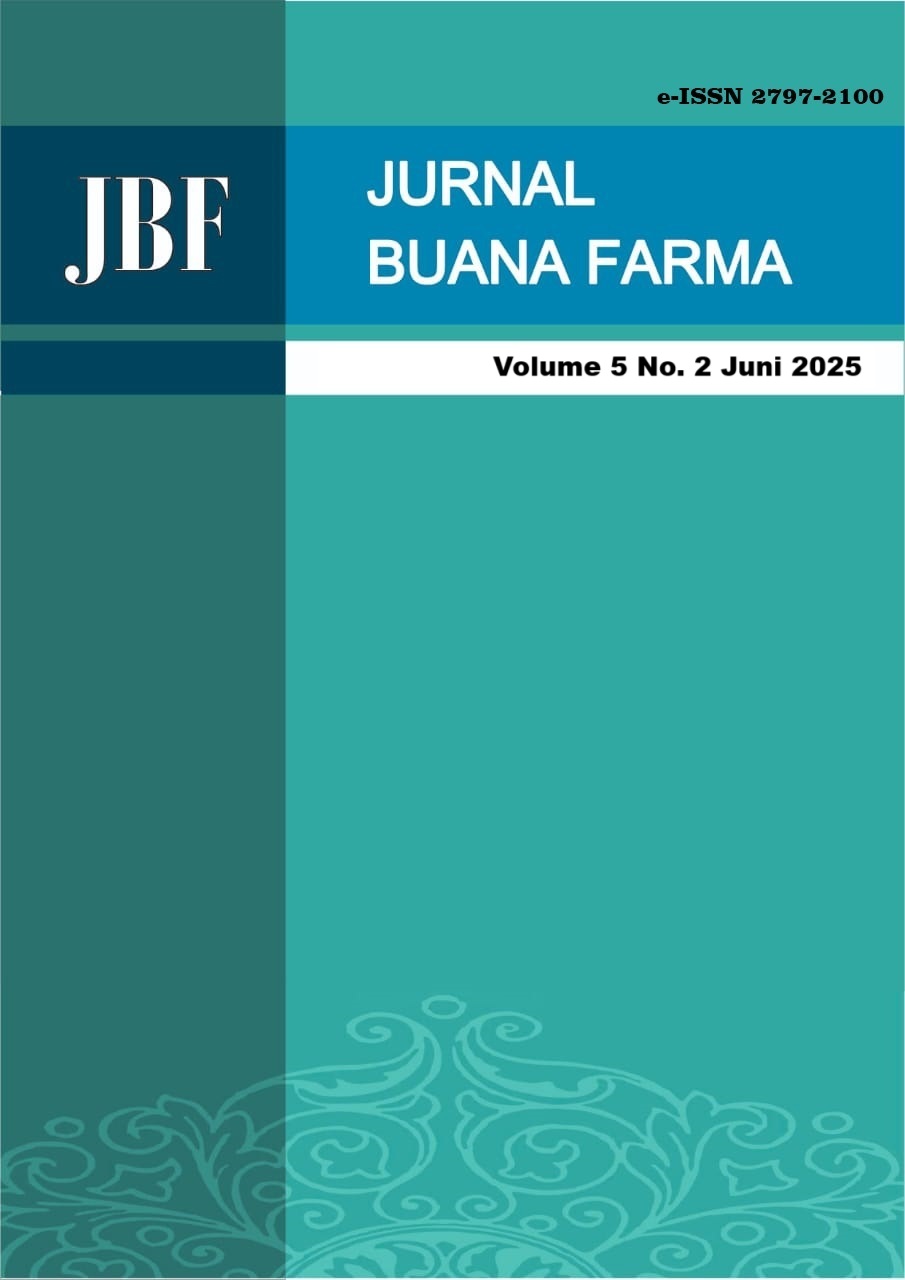ARTIKEL REVIEW : AKTIVITAS ANTIOKSIDAN BUNGA MAWAR MERAH (Rosa damascene Mill.)
Abstract
Red rose (Rosa damascena Mill.) is an ornamental plant that is rich in bioactive compounds such as flavonoids, anthocyanins, phenols, vitamin C, tannins, and saponins that function as natural antioxidants. The purpose of this article is to review research results related to the antioxidant activity of red rose flowers in various dosage forms and extraction methods. This review was conducted through a literature review of 10 selected scientific articles in the range of 2015-2025 using the exclusion and inclusion method. The results showed that most of the red rose flower extracts showed very strong antioxidant activity, characterized by IC₅₀ values < 50 ppm, even in some studies reaching < 20 µg/mL. Antioxidant activity is influenced by the type of solvent, temperature and processing time, as well as the combination of ingredients such as bengkoang or mint leaves. Polar extracts such as ethanol and methanol tend to give the best results, while high temperature treatment and long heating times tend to reduce the effectiveness of active compounds. Thus, rose red flowers have great potential as a source of natural antioxidants that can be utilized in functional food, cosmetic, and pharmaceutical products.References
Afifah et al. (2020). Antioxidant Activity Of Red Rose Leaves (Rosa chnensis Jac.) Extract. Acta Biochimica Indonesiana, 3-2.
Amy, T. &. (2022). Chemical Properties of Red Rose (Rosa Indica L.) Herba Tea With Variations of Temperature and Drying Time. Jurnal Teknik Kimia, 33-38
Anugrah et al. (2021). Uji Aktivitas Antioksidan Alga Cokelat Saragassum sp. Dengan Metode 1,1-Difenil-2-Pikrihidrasil (DPPH). Pattimura Medical Review, 3-1.
Faiza et al. (2025). Formulasi Sediaan Serum Antioksidan Dari Ekstrak Bunga Mawar Merah (Rosa damascena Mill.) dan Virgin Coconut Oil (VCO). Indonesian Journal Of Mathematics And Natural Sciences, 48-1.
Hasyim et al. (2022). A Review : Potensi Tumbuhan - Tumbuhan Di Indonesia Sebagai Antioksidan Alami. Seminar Nasional Penelitian LPPM UMJ, 28-1.
Kurnianti et al. (2023). Antioxidant Activity Of Rose Tea (Rosa damascena) With Various Types Of Sugar And Rose Tea Concentration. Jurnal Teknolosi dan Industri Pangan Unisri, 8-2.
Lobianna et al. (2020). Activity Of Rose Flower Extract And Resepthakulum As Antioxidant And Anti-tyrosinase. International Conferences On Health Informatics, Medical, Biological Engineering, and Pharmaceutical, 17-22.
Mareetha et al. (2021). Antioxidant Activity Of Red Rose Petals Extract (Rosa damascena Mill). Journa Of Pharmaceutical Research International, 186-192.
Maziyyah et al. (2018). Uji Aktivitas Antioksidan Kombinasi Ekstrak Bunga Mawar (Rosa damascena Mill) Dan Umbi Bengkoang (Pachyrizus erosus). Mulawarman Pharmaceutical Conference, 20-21.
Munira et al. (2024). Uji Aktivitas Antioksidan Ekstrak Beberapa Jenis Bunga Dengan Metode DPPH (1,1-Diphenyl-2-picrylhydrazil). Jurnal Ilmiah Farmasi Simplisia, 4-1.
Rizkya, A. &. (2024). Comparison Of Antioxidant Activity Of Fresh Rose Flowers (Rosa damascena Mill) And Rose Tea With Different Drying Methods. BIO Web Of Conferences, 14-8.
Romisna et al. (2024). Skriining Fitokimia dan Aktivitas Ekstrak Bunga Mawar (Rosa damascena Mill). Journal of Social Science Research, 4-4.
Saati et al. (2020). Utilization Of Rose Flower Extract As Antioxidant Rich - Drink. Second International Conference On Sustainable Agriculture, 45-8.
Sutardi, Y. &. (2021). Uji Aktivitas Antioksidan Air Mawar (Rose Water) Dari Petal Bunga Mawar Merah (Rosa damascena Mill) Menggunakan Metode DPPH (Diphenyl Picril Hidrazil). Jurnal Teknologi Industri Pertanian, 15-3.













